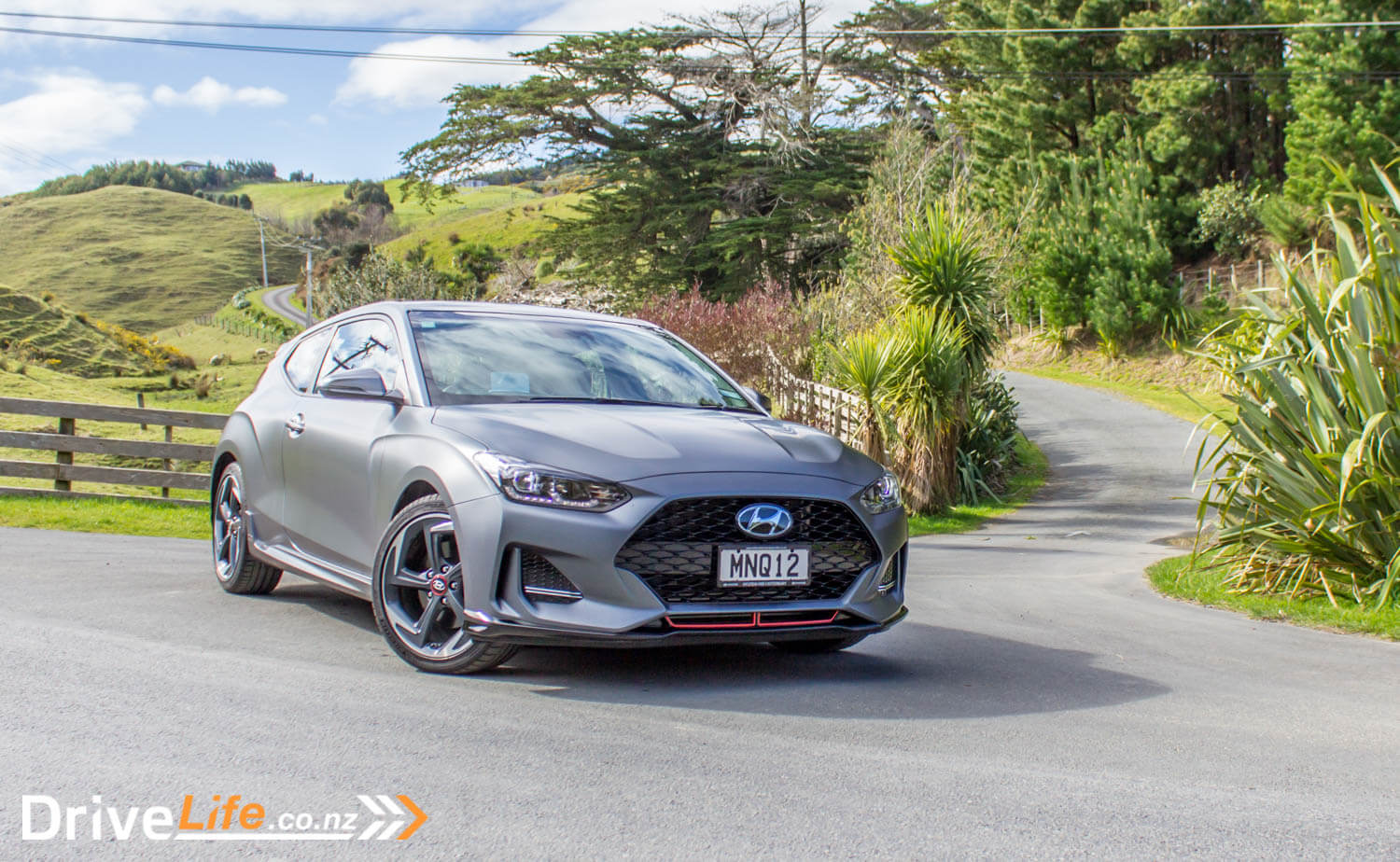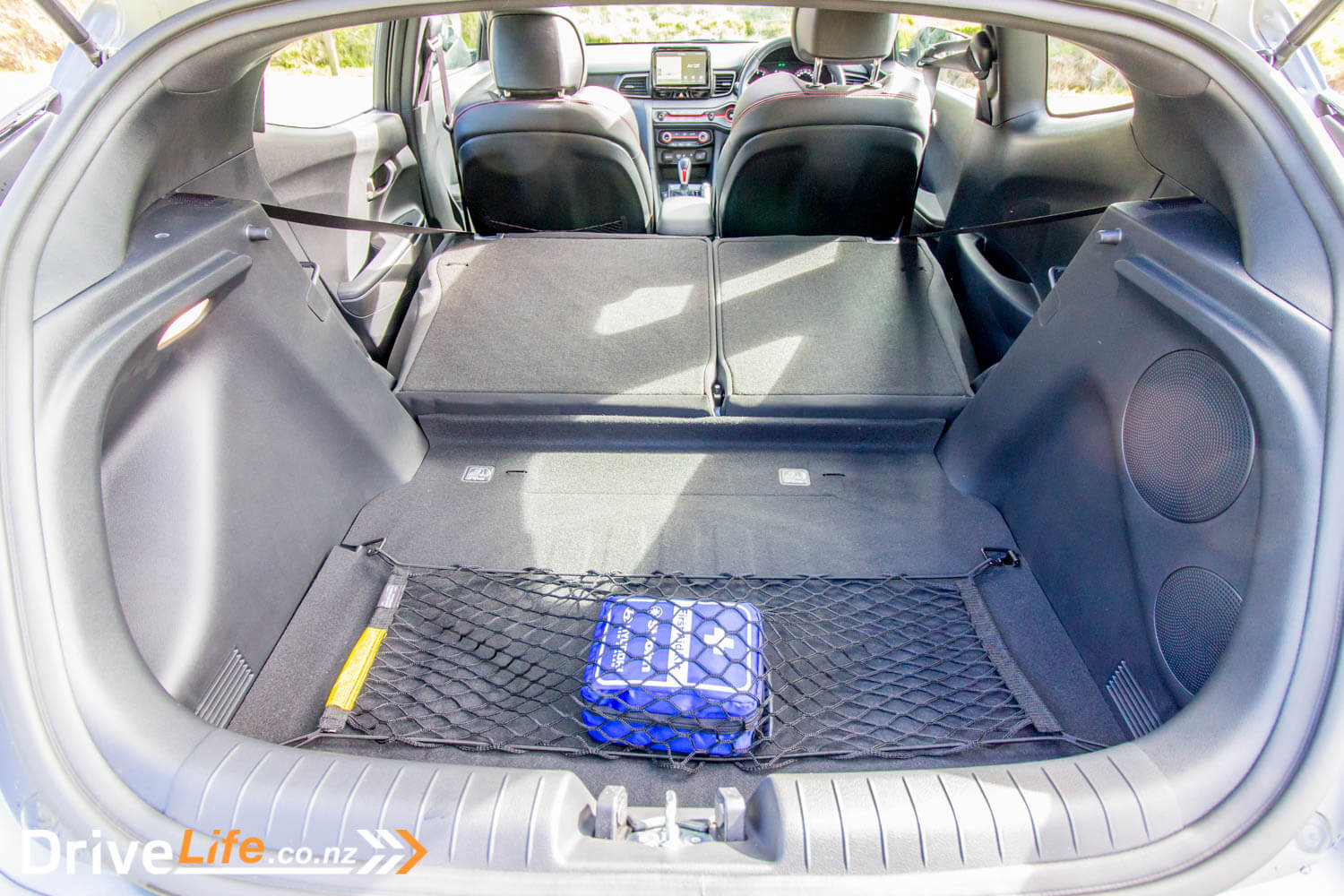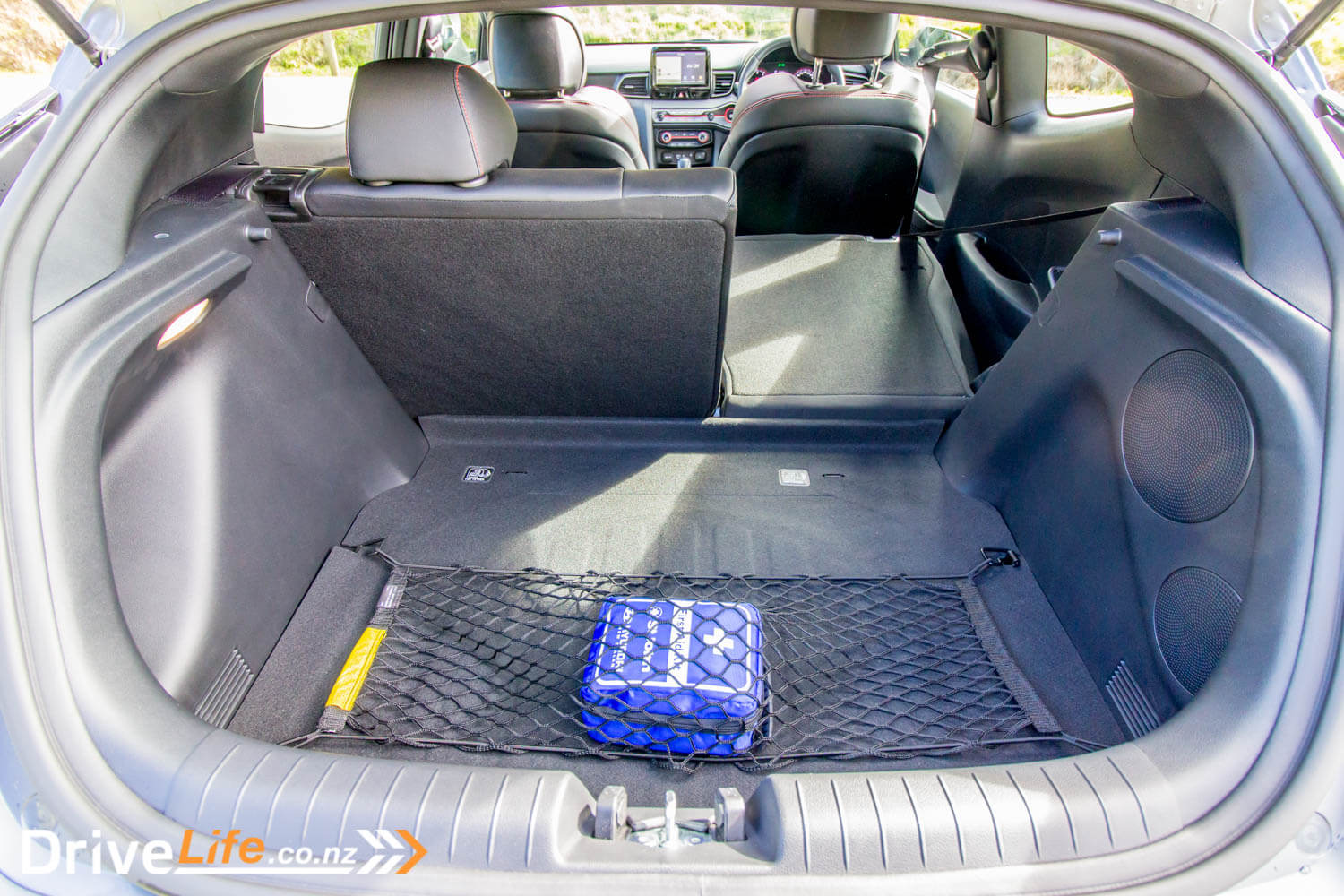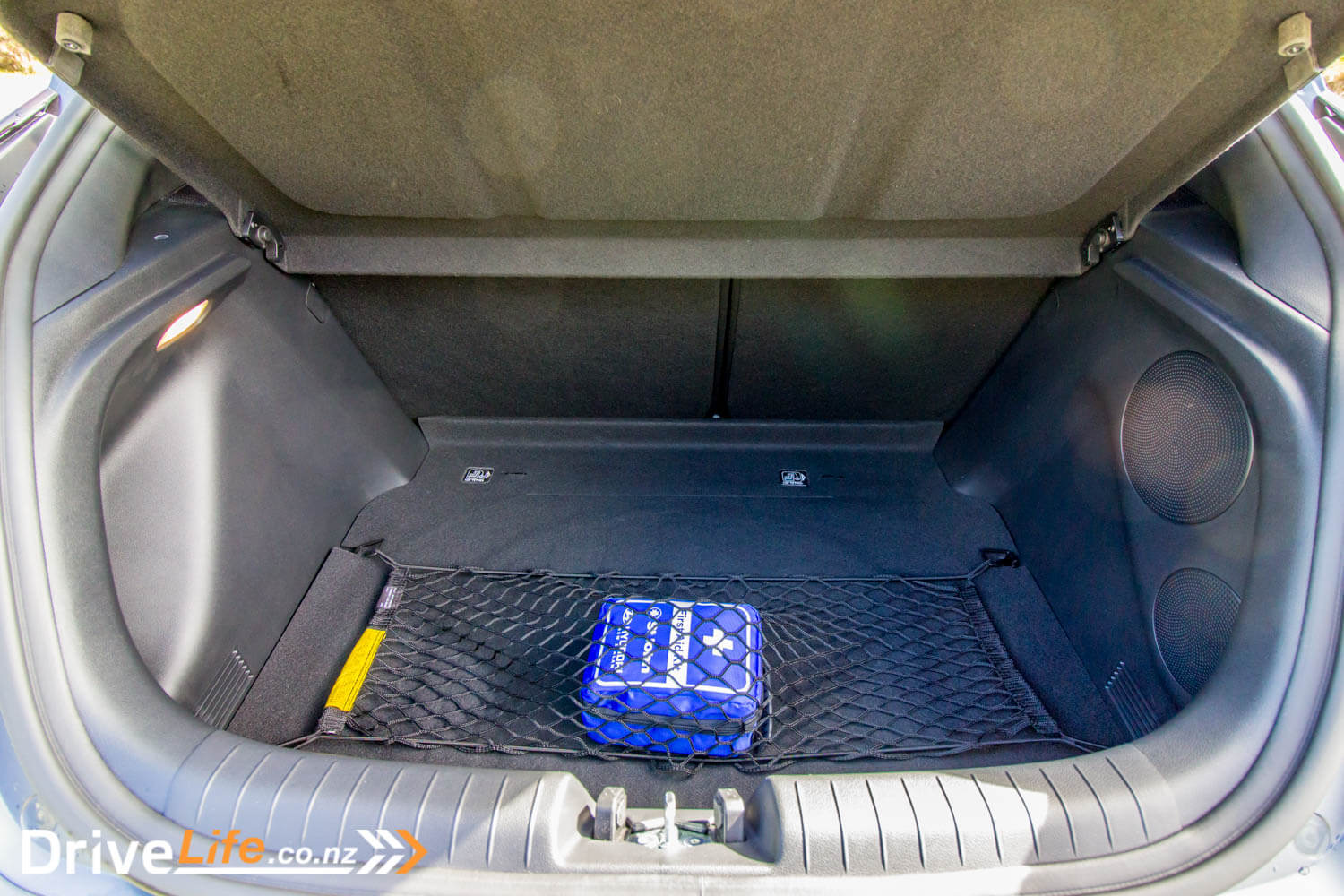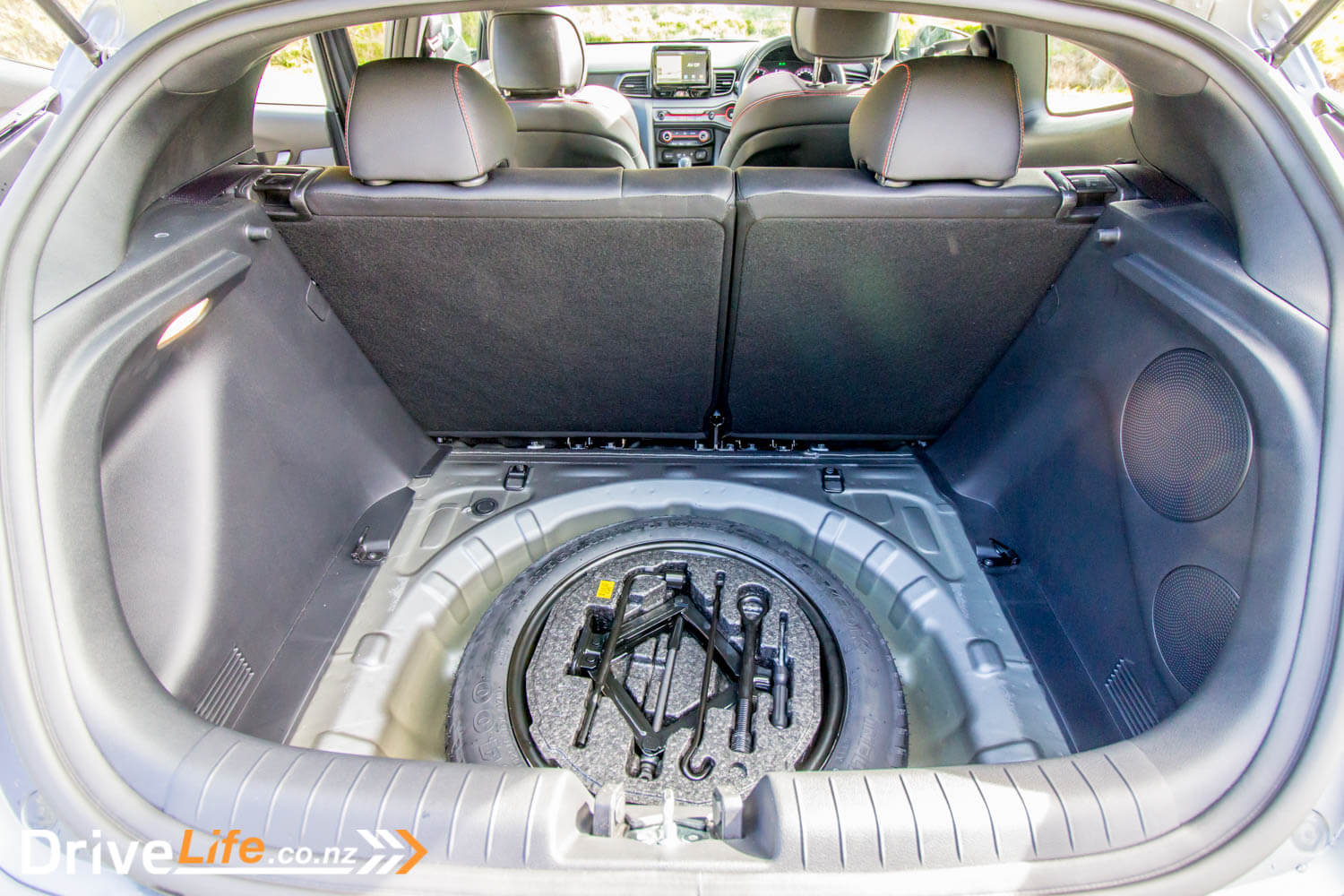We reviewed the Elite model Veloster back in June, and really enjoyed that car; great handling for a base model, reasonable performance and an eye-catching design. There was a lot to like.
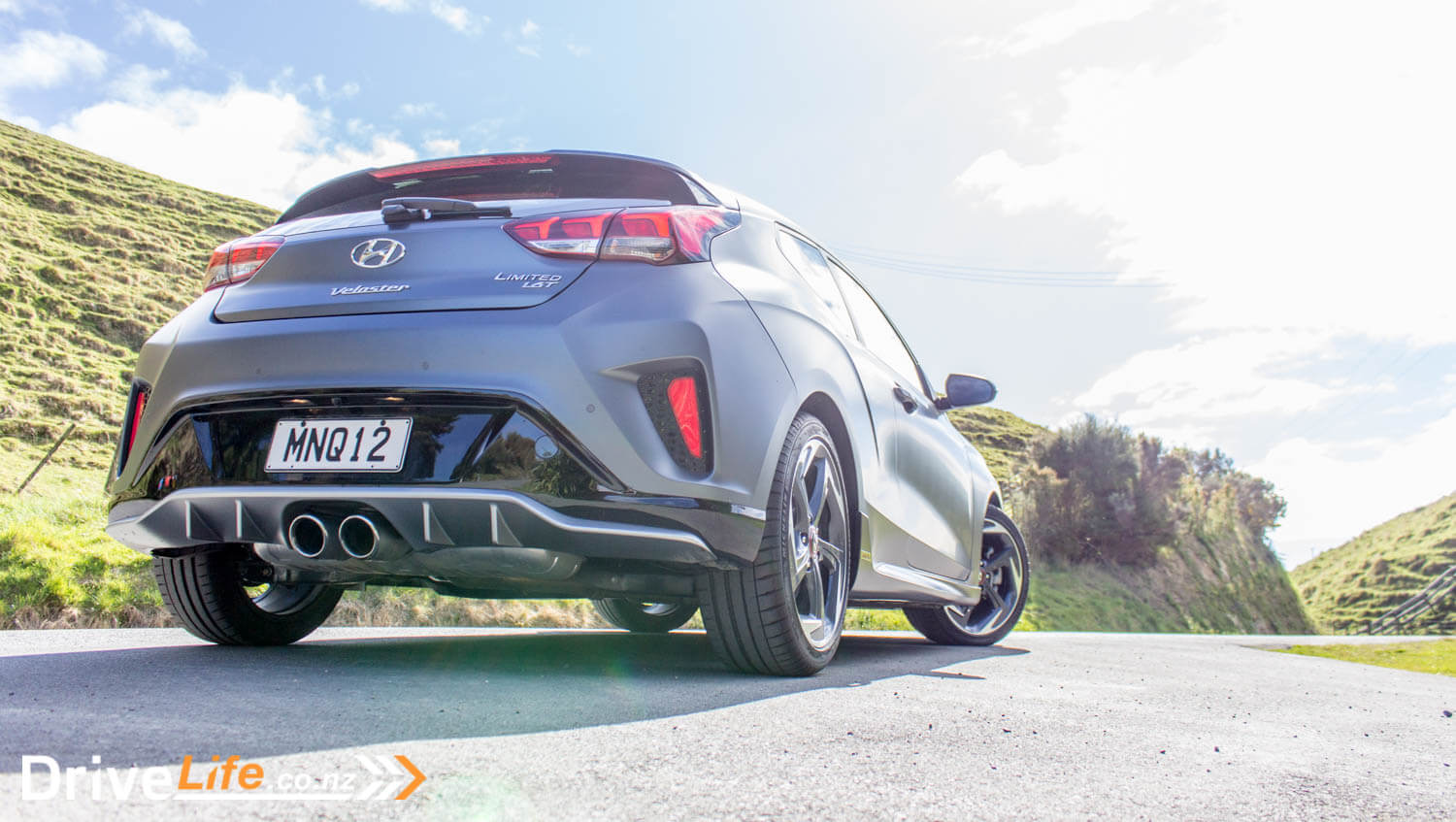
But still, I lusted after the Limited model with its 1.6 turbo motor. While the normally aspirated 2.0-litre performed well, it was no i30N. It wasn’t trying to be, but the chassis of that model felt like it could handle more power. And so we come to the Veloster Limited. Power goes up from 110kW to 150kW, and torque goes from 180Nm to 165Nm. The price goes up too, by $7,000.
With an automatic gearbox as the only option, could the Veloster Limited be the lazy man’s i30N?
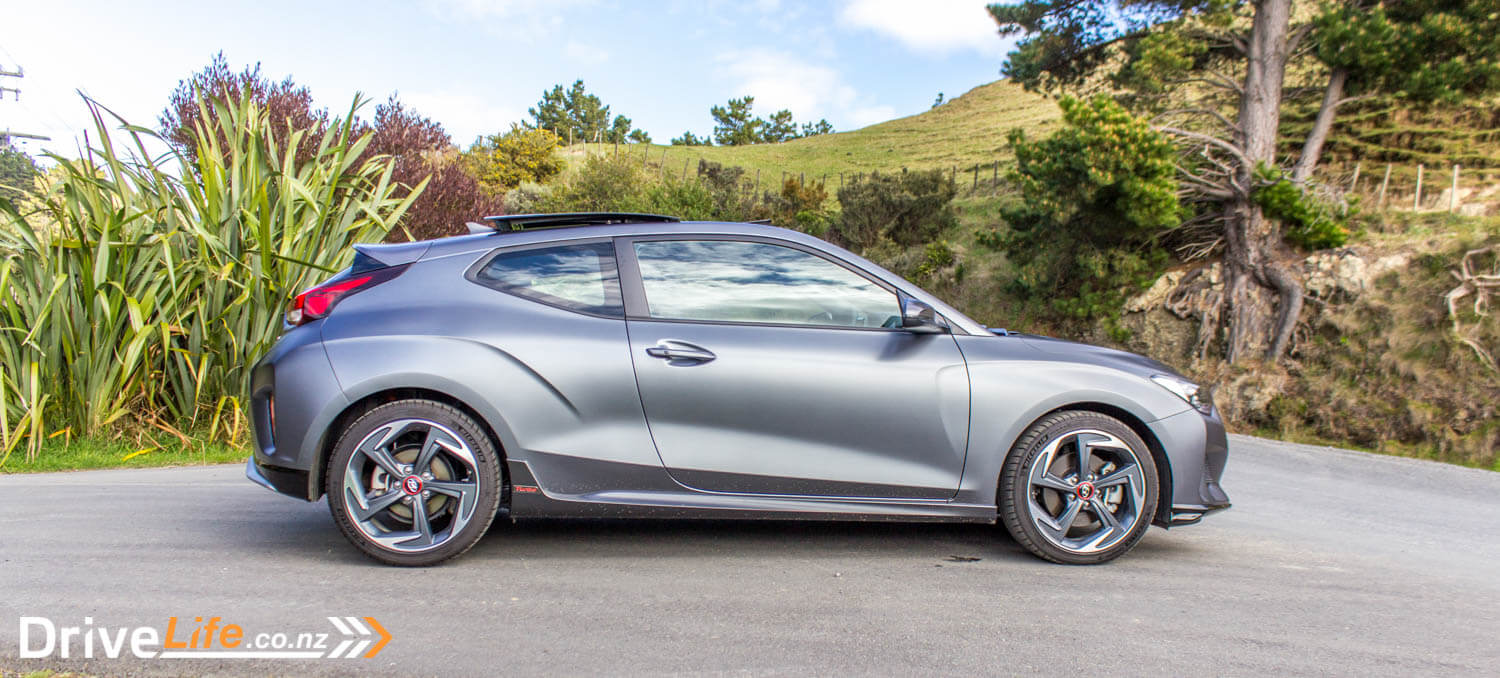
What’s In The 2020 Hyundai Veloster Range?
You can read the full specs of each model in the previous review, but in a nutshell, along with a different engine, the Limited gets a 7-speed DSG gearbox in place of the non-turbo’s ‘normal’ automatic.
There’s also the nice addition of a heads-up display (HUD), heated and cooled seats, a heated steering wheel, full leather, an electric sunroof, SatNav with traffic updates, Michelin Pilot Sport tyres, some stunning alloy wheels, as well as some other trinkets.

The Veloster Elite is $45,990, while the Limited retails at $52,990.
You can read more about the Veloster on Hyundai New Zealand’s website.
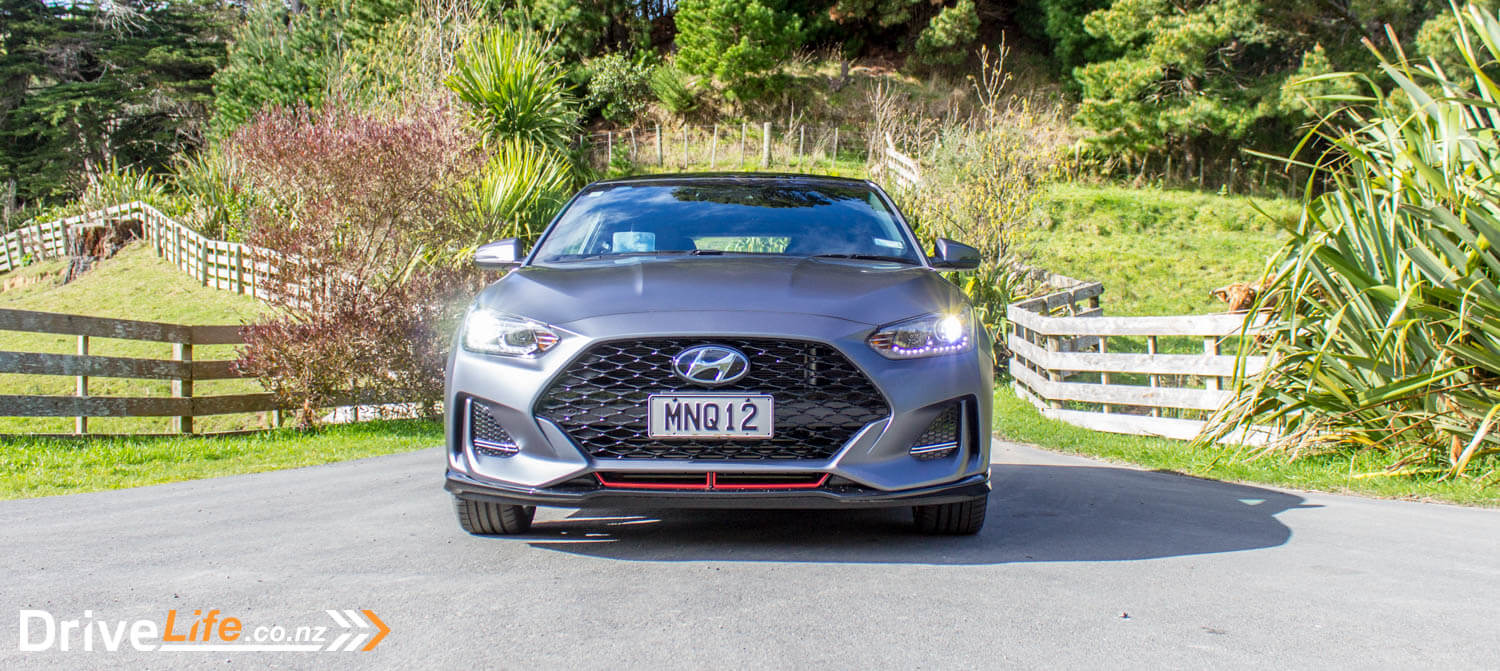
First Impressions Of The 2020 Hyundai Veloster Limited
Many readers will know that to put it lightly, I’m not a fan of grey or silver (a.k.a metallic grey) cars. They’re so common, and on our roads are invisible to many drivers coming towards you. I know one person who was rear-ended three times in 12 months driving his grey car. He changed to a red car, and the rear-ending disappeared.
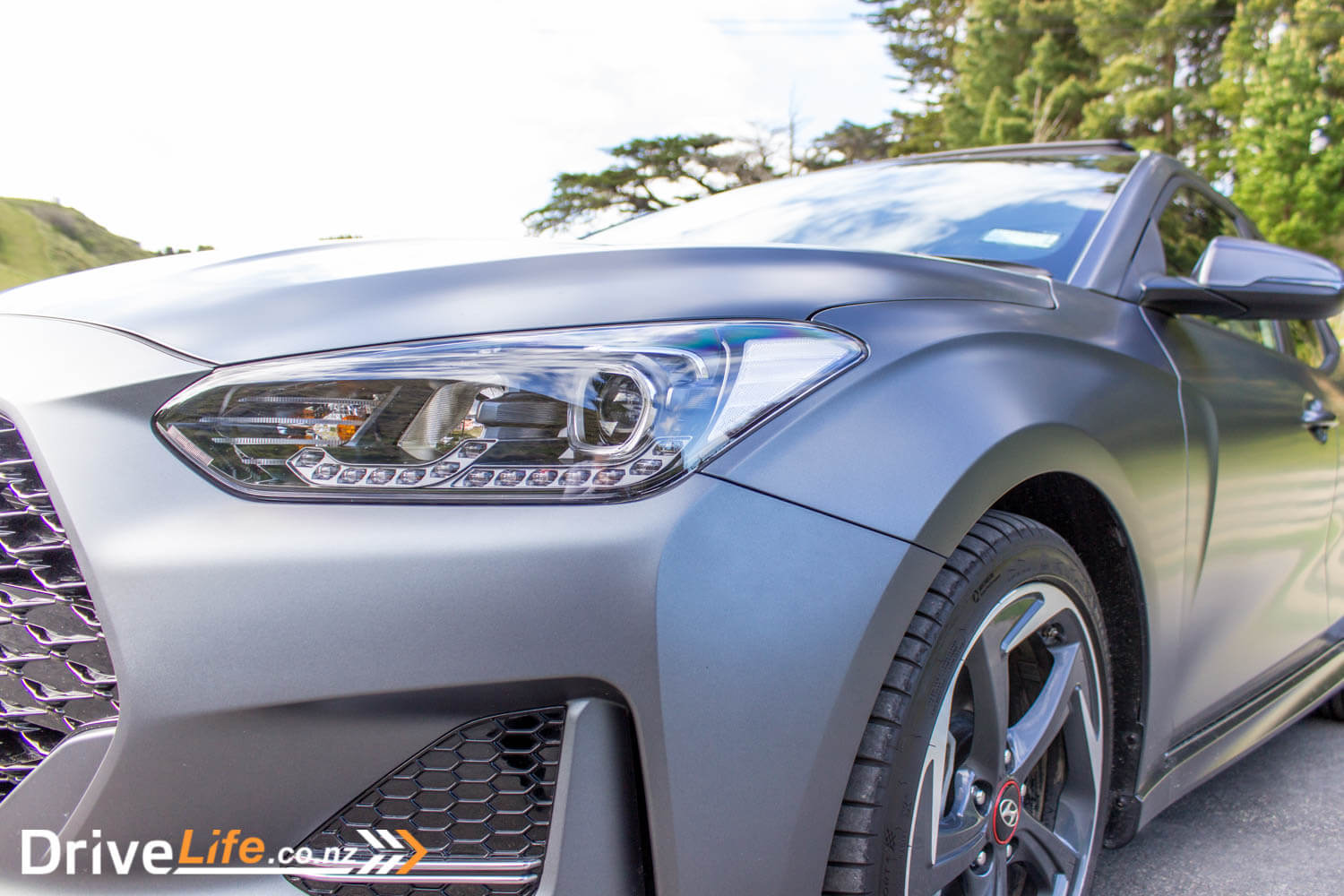
You would think then that I’d be pretty disappointed that our test Veloster was finished in Space Grey, a matt grey. First impressions? I was, but after a week, I was sold on it. With this shape, those wheels and that colour, the Veloster Limited is near-on stunning – from any angle.
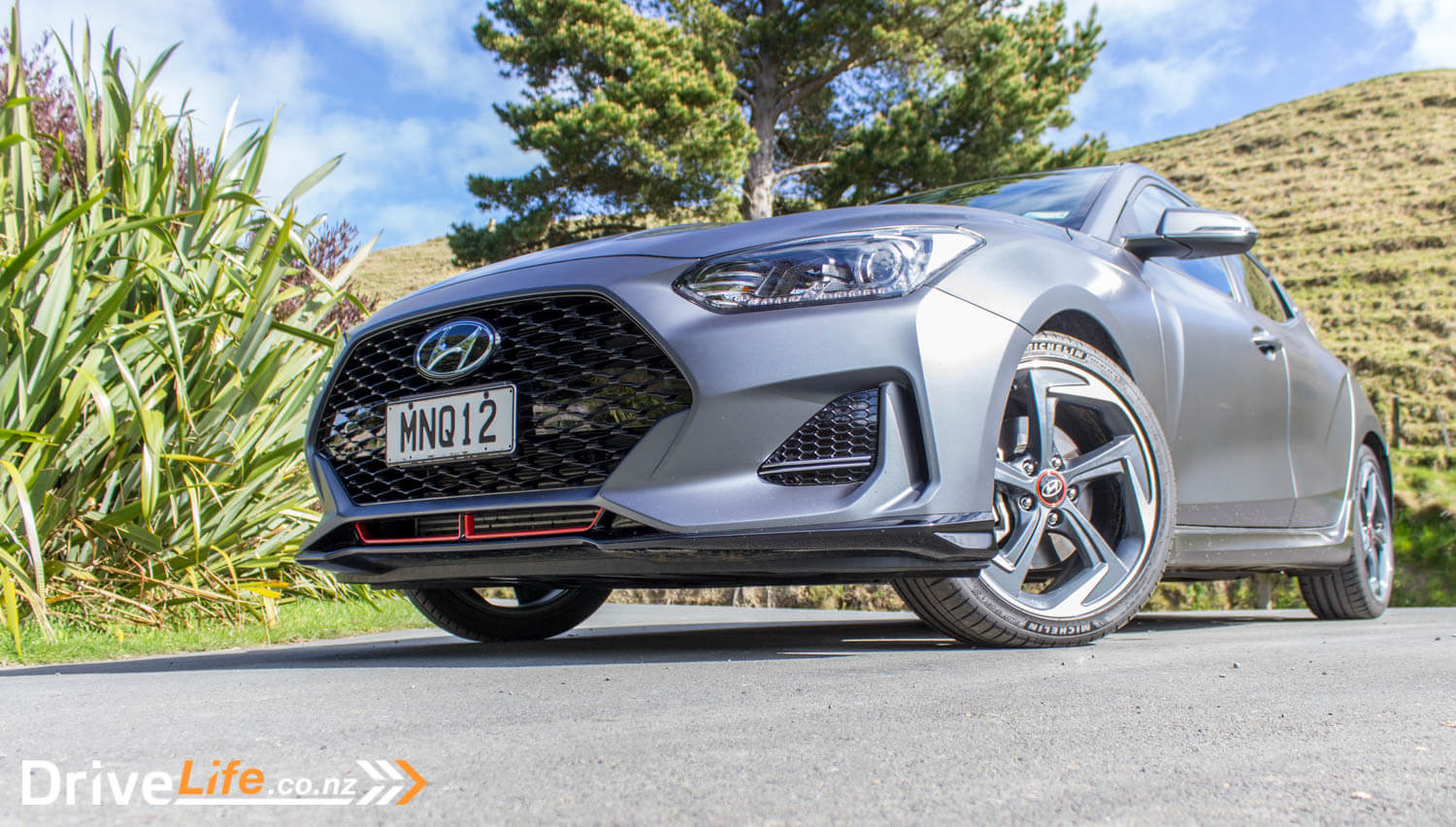
While it’s still an OCD throwback with its single door on the driver’s side and two doors on the passenger’s side, it’s a fantastic looking car, and that colour couldn’t be a better match for it.
With a splash or red at the front, and those two sexy-as-hell exhaust tips at the rear, the Veloster looks the business in your rear mirror, or as it disappears away in front of you. I love it.
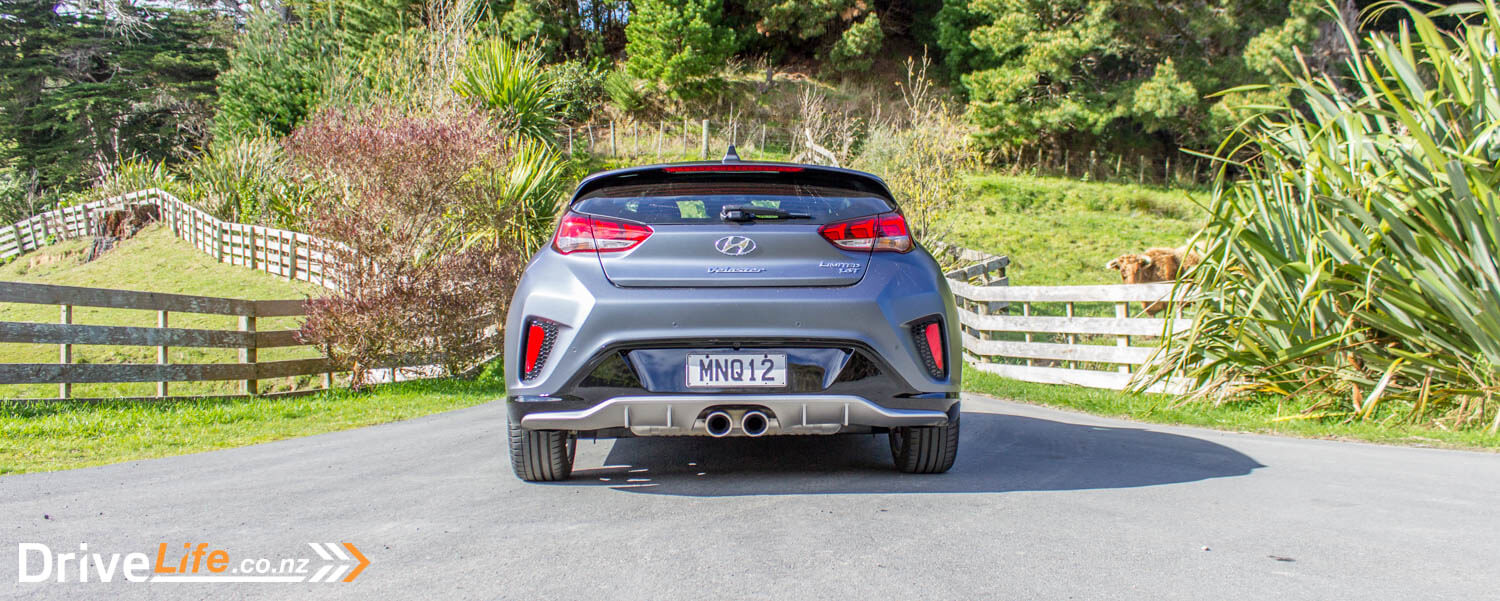
What’s The Interior Like On A 2020 Hyundai Veloster Limited?
You can read more about the interior in the Veloster Elite review, but it’s worth looking at the improvements with the Limited model.
Seats still have the red line through the middle of them, so no change there. But they are now full leather, instead of a cloth/leatherette mix. The driver’s seat is now electric, but weirdly it’s only fore/aft and up/down, so the backrest angle is still manual. There is an electric two-way lumbar adjust, though.
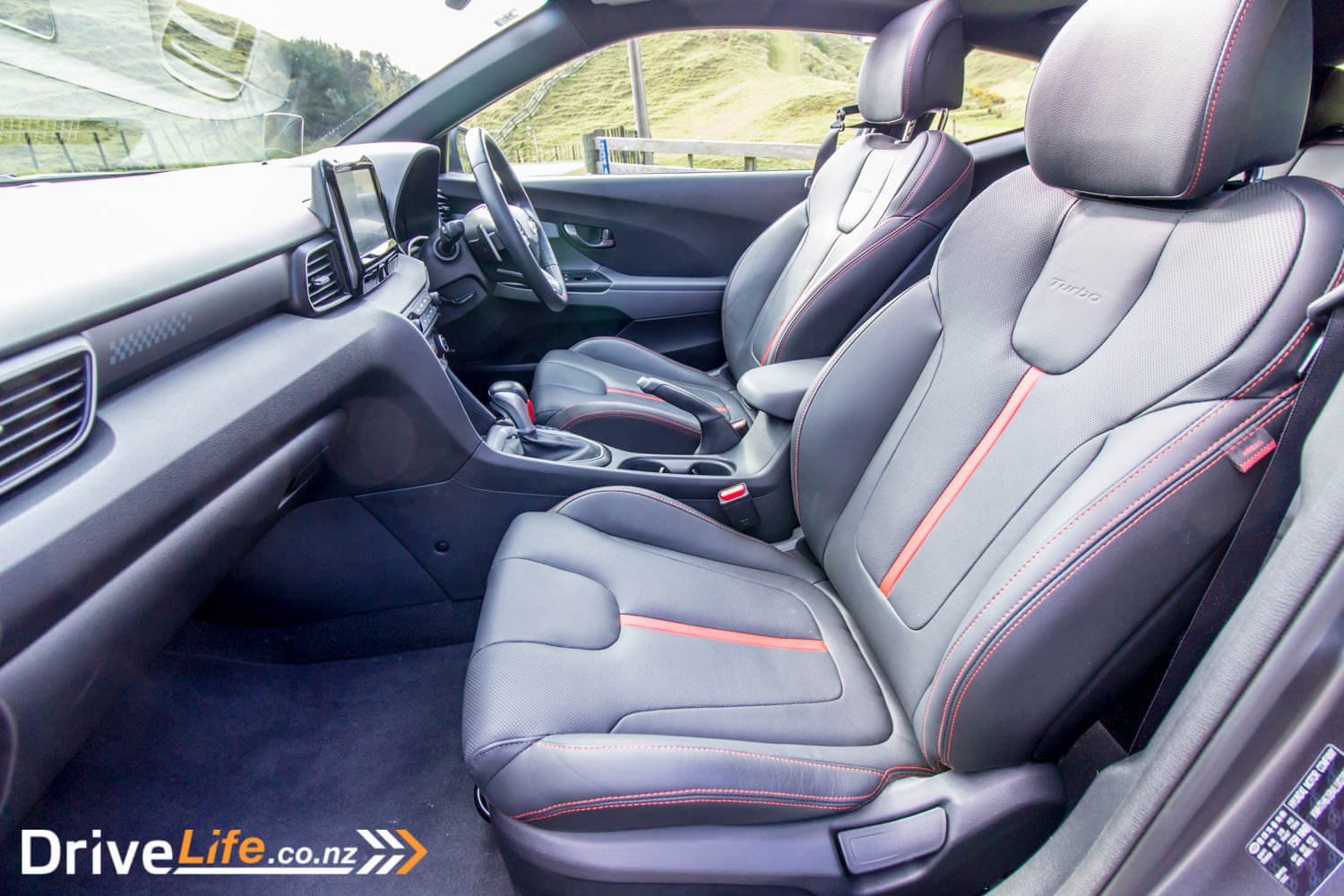
The red line is carried through the steering wheel, dash, and gear shifter, so this is the same as the Elite model. Actually, the interior is pretty much the same as the base model – it doesn’t look particularly racier in any way, although the alloy pedals are a Limited-only addition.
Like the Elite, there’s acres of flat, hard, black plastic in the Veloster’s interior. Hyundai really needs to go and check out the opposition to see what others are doing in this regard. For $53K, it should feel less like a cheaper car than it does.
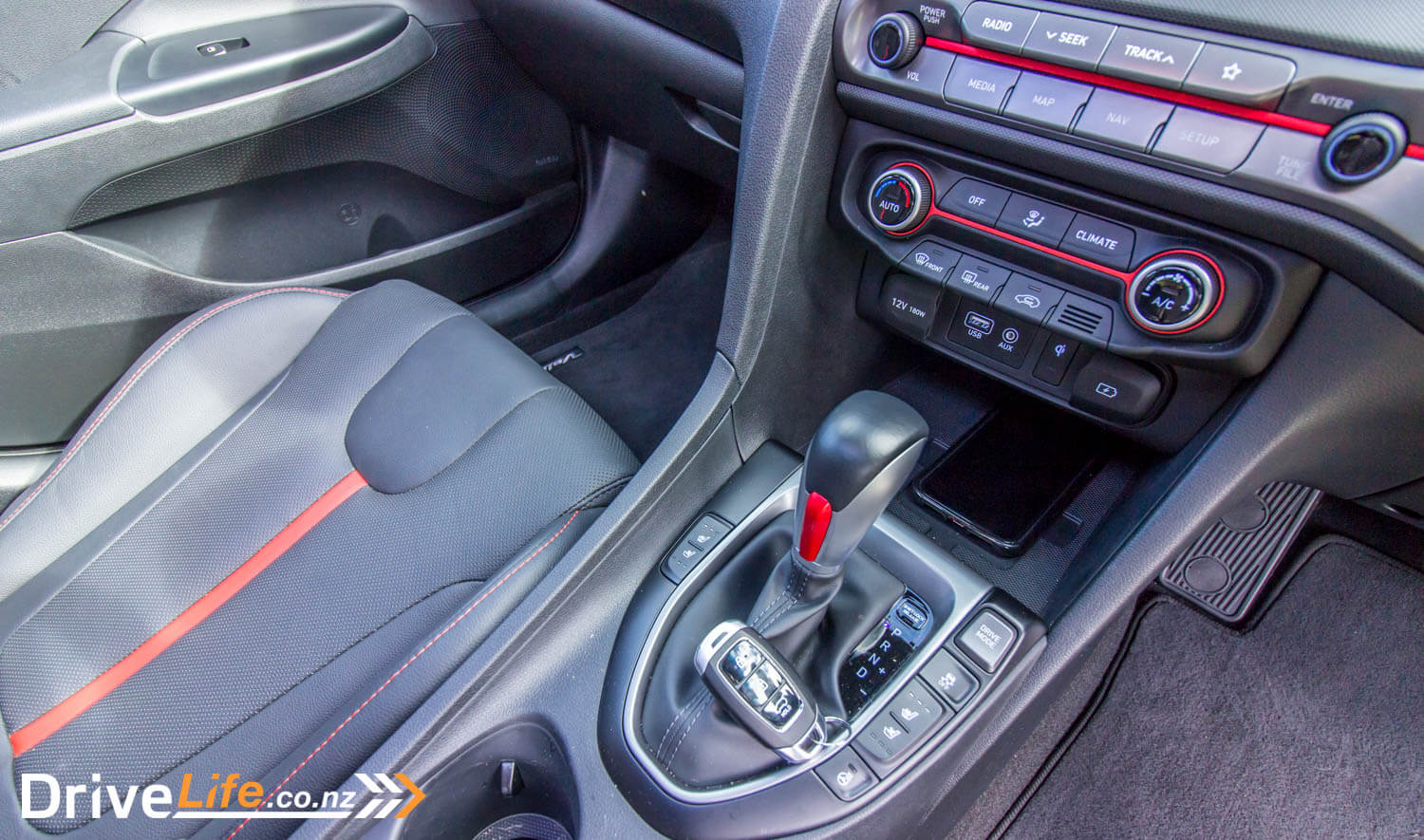
Strangely, the checkered flag pattern that’s on the faces of the speedo and rev counter in the Elite model are not the same in the Limited – it’s just a black background. With this being the higher-performance model, I would have thought it’d be the other way around.
Rear legroom is unchanged of course; it’s okay, but not great. Headroom in the rear of the Elite is reduced due to the tilt/slide electric sunroof (with an electric blind), so it’s a fairly tight fit back there.
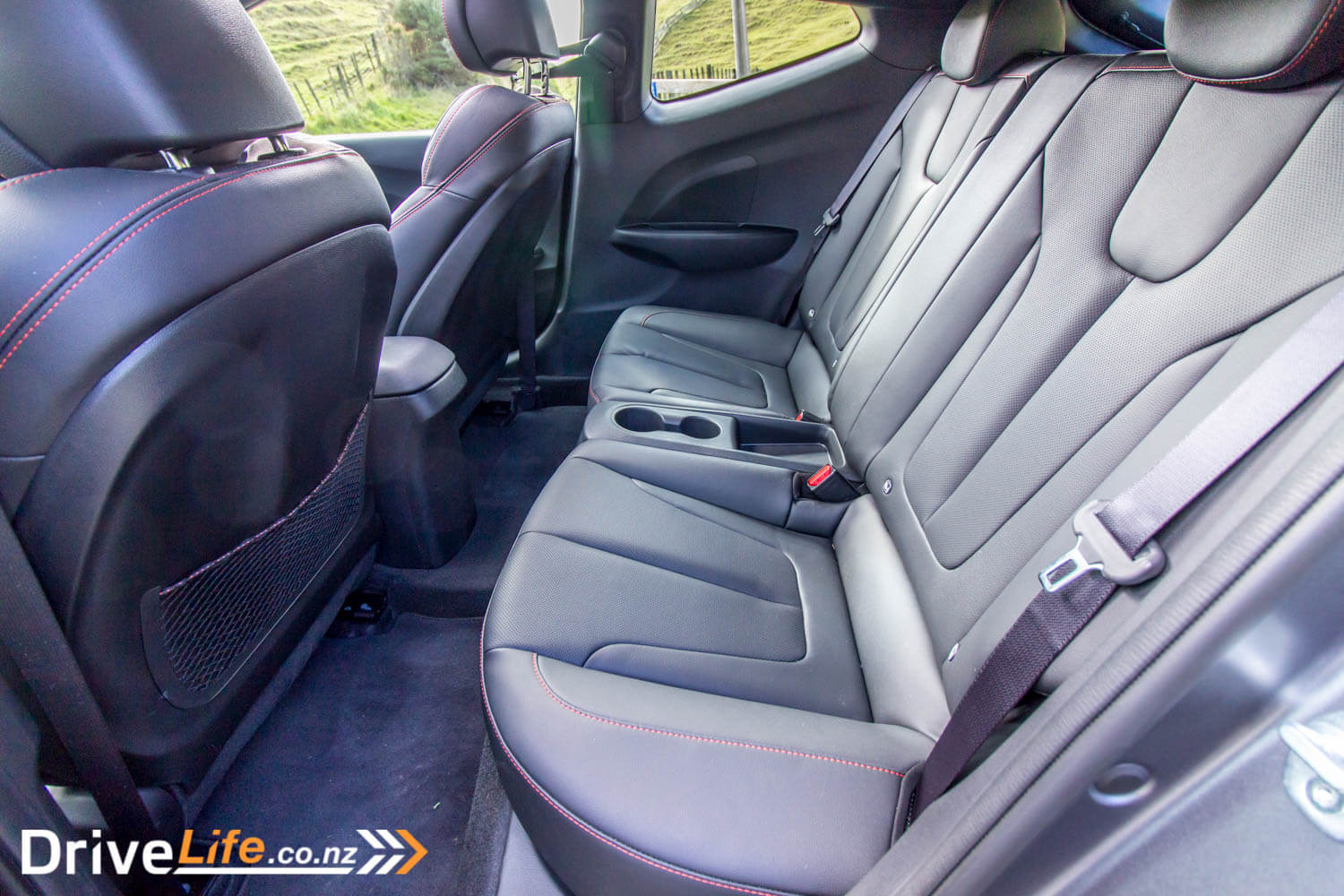
What’s The 2020 Hyundai Veloster Limited Like To Drive?
It’s all down to this – the drive. I don’t believe any Veloster buyer is going to go for the Elite because it has heated seats; they are looking for extra performance over the 2-litre. With 150kW of power, performance should be very good. But how does it compare to the slightly more expensive, 203kW i30N?
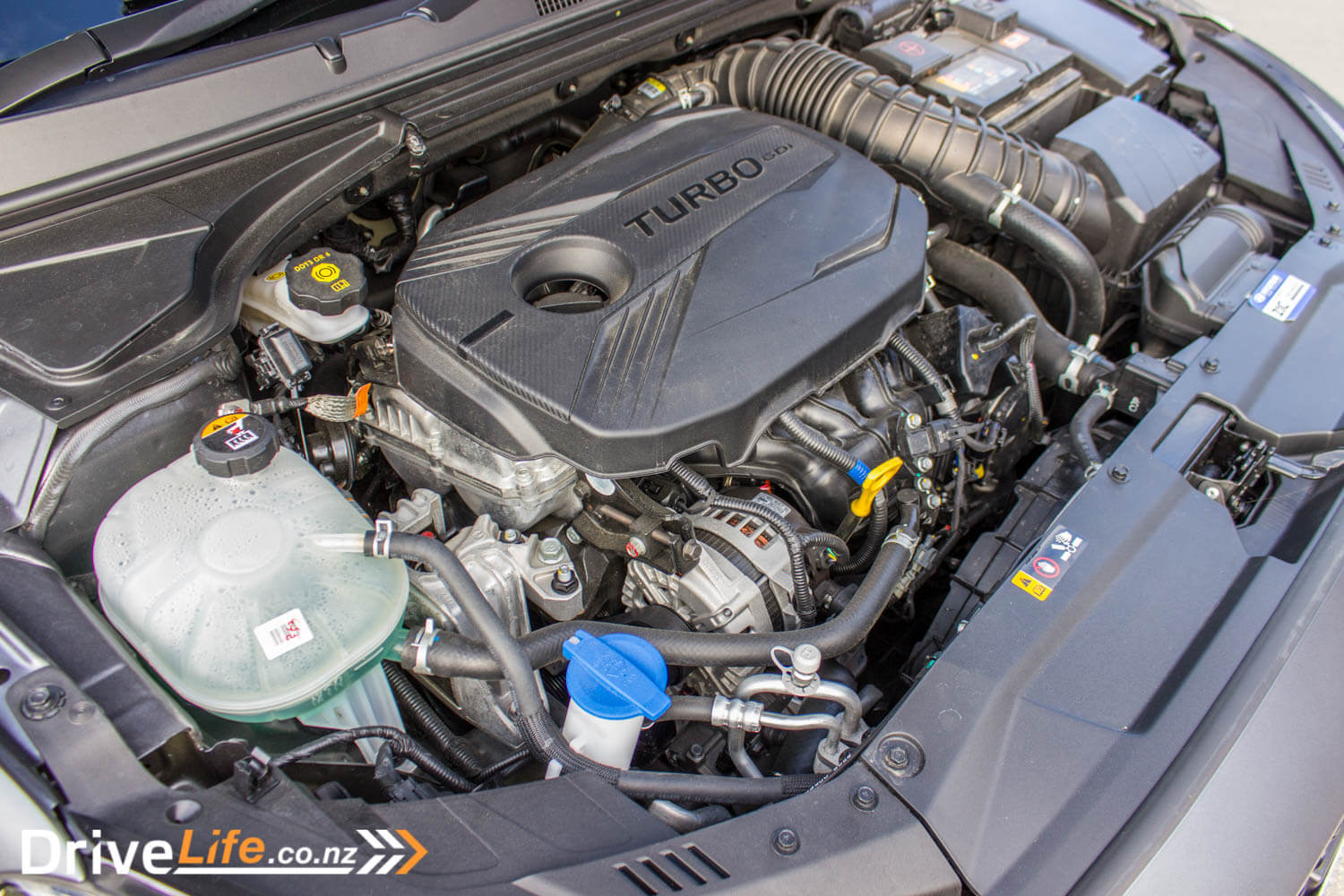
It does well. Even starting the car cold will bring a nice burble from the back of the car, a sign of things to come. The gear lever falls perfectly to hand too, as you settle in for The Drive. As you’d expect, it’s less frantic than the i30N, and the automatic ‘box helps in this department. After a little bit of turbo lag, it’s quick off the line in any drive mode, although full-throttle starts will see a lot of wheel spin, and a good amount of axle tramp as well. There’s only so much power front wheels can take before physics takes over. Still, you can feather the throttle quite nicely, and manage to get the power down easily in the dry, if you can resist full throttle. It does feel much faster than the 7.1 seconds 0-100kmh time suggests.
Then of course, there’s the sound it makes. Again, it’s not an i30N, but in Sport mode, it will still bring a grin. There’s some nice crackles on the upshift as well, and you’ll get these even on a quarter throttle in Normal drive mode. Over my time with the Veloster turbo, I got more used to the power and more appreciative of it. In many ways, it’s a lot more usable than the i30N. With that DSG automatic, it could be a solid Daily Driver, with an abundance of power in reserve for overtaking, or the occasional burst away from the lights.
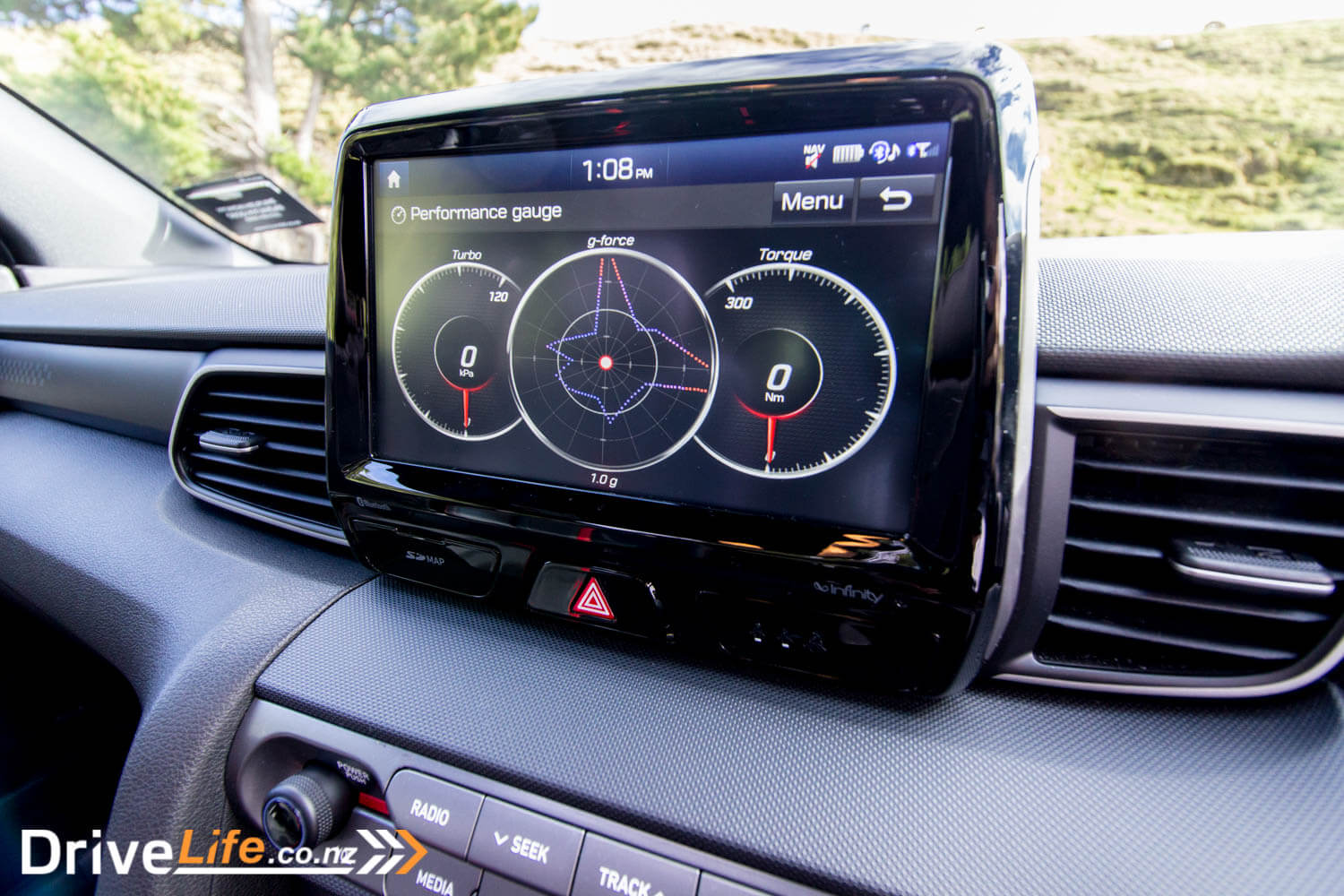
Midrange acceleration is impressive too, especially in Sport mode. On the motorway, a stab of the right pedal will see the car changing down and shooting forward effortlessly.
Once you get off the motorway and into the twisty stuff, the Veloster Limited can still hustle. It’s not as flat as the i30N on the twistier bends, and understeer will come as you push on, but the grip is there with those Michelin Pilot Sports doing what they do best. Steering, which is heavier even around town, starts to come into its own on a windy road, with a reasonable amount of steering feel. Near the limit of adhesion, it’s hard to tell what the front wheels are doing, but most times feel is good.
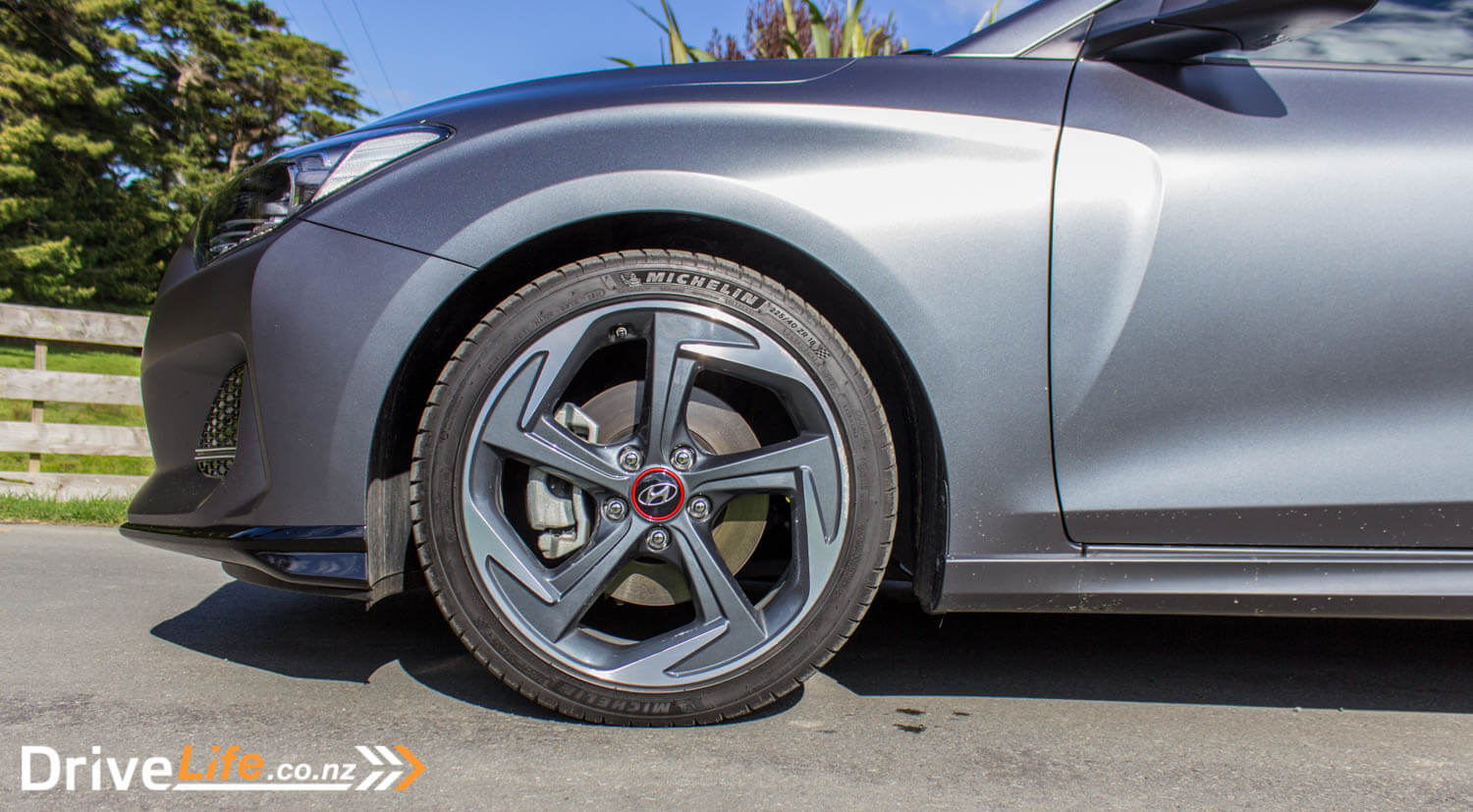
A nice feature of the Limited is when you slip the gear lever to the right to put the car in manual gearbox mode. Instantly the car goes into Sport mode, and with that a huge rev counter appears on the Heads-Up Display, and the gauges have a red ring around them, just so you know the car understands it’s Business Time. Keeping the car over 4,000rpm on windy roads is your best approach, as it removes any turbo lag, and also you get the nice noises from the back of the car. This is a time to open that sunroof and windows, with the best sounds coming from 5,500-7,000rpm.
The brakes that can feel soft around town, show their power when you start to hammer them, and will cope with the most demanding of drives. You can modulate the pedal quite nicely, and brake feel is on the higher end of very good.
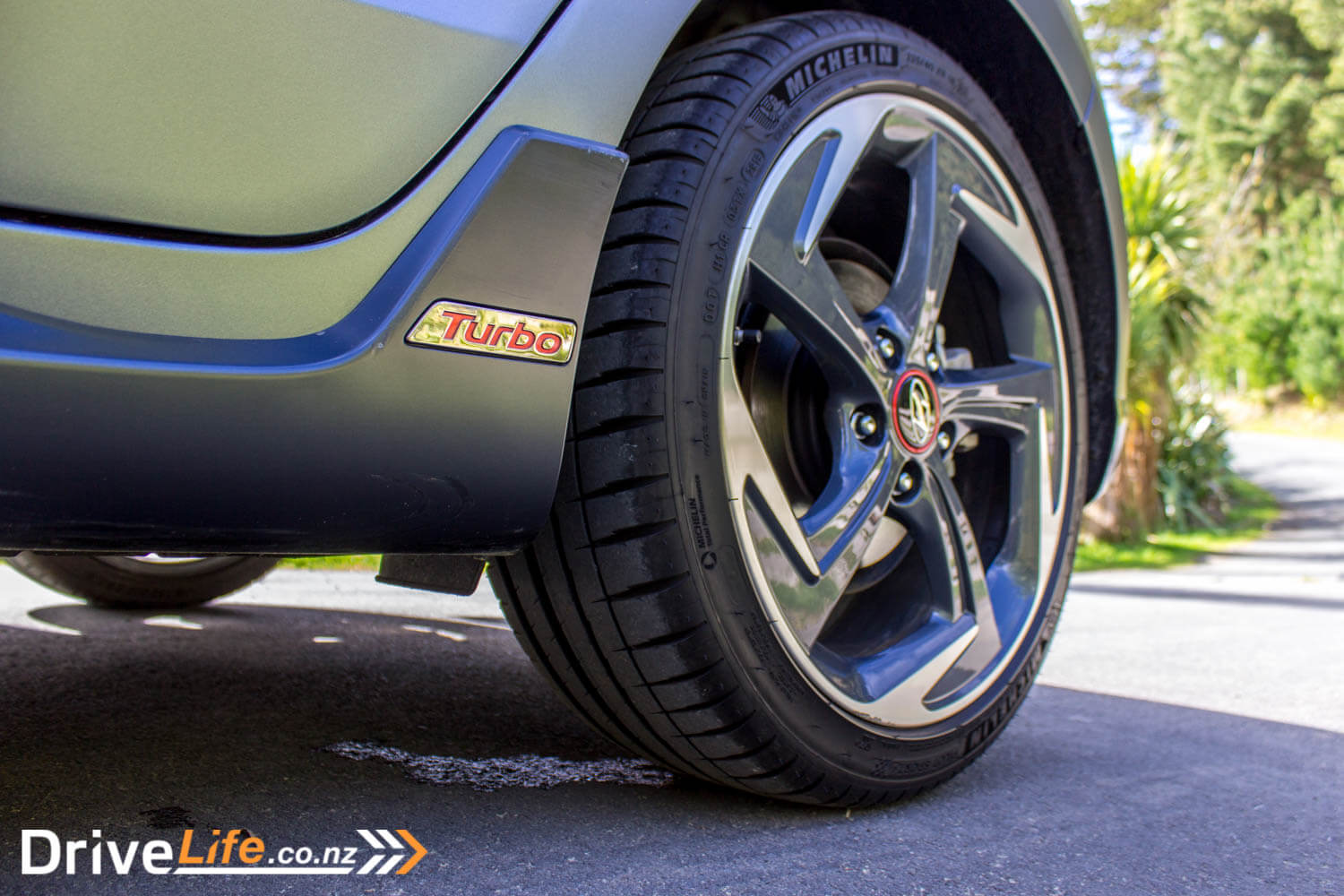
But not everything is rosy. That DSG transmission lets the car down as a Daily Driver. It’s jerkier than other DSGs at low speed, and spends a lot of time riding the clutch. A slight incline is not the Veloster Limited’s friend, and I felt like I spent too much time either waiting for the gearbox to select a gear when moving it into Drive or Reverse, or waiting for the clutch to pick up when accelerating away. Once on the move it’s just fine, and using half or more of the throttle will see very quick gear changes. But around town, and from a stop sign/red light, it can be frustrating.
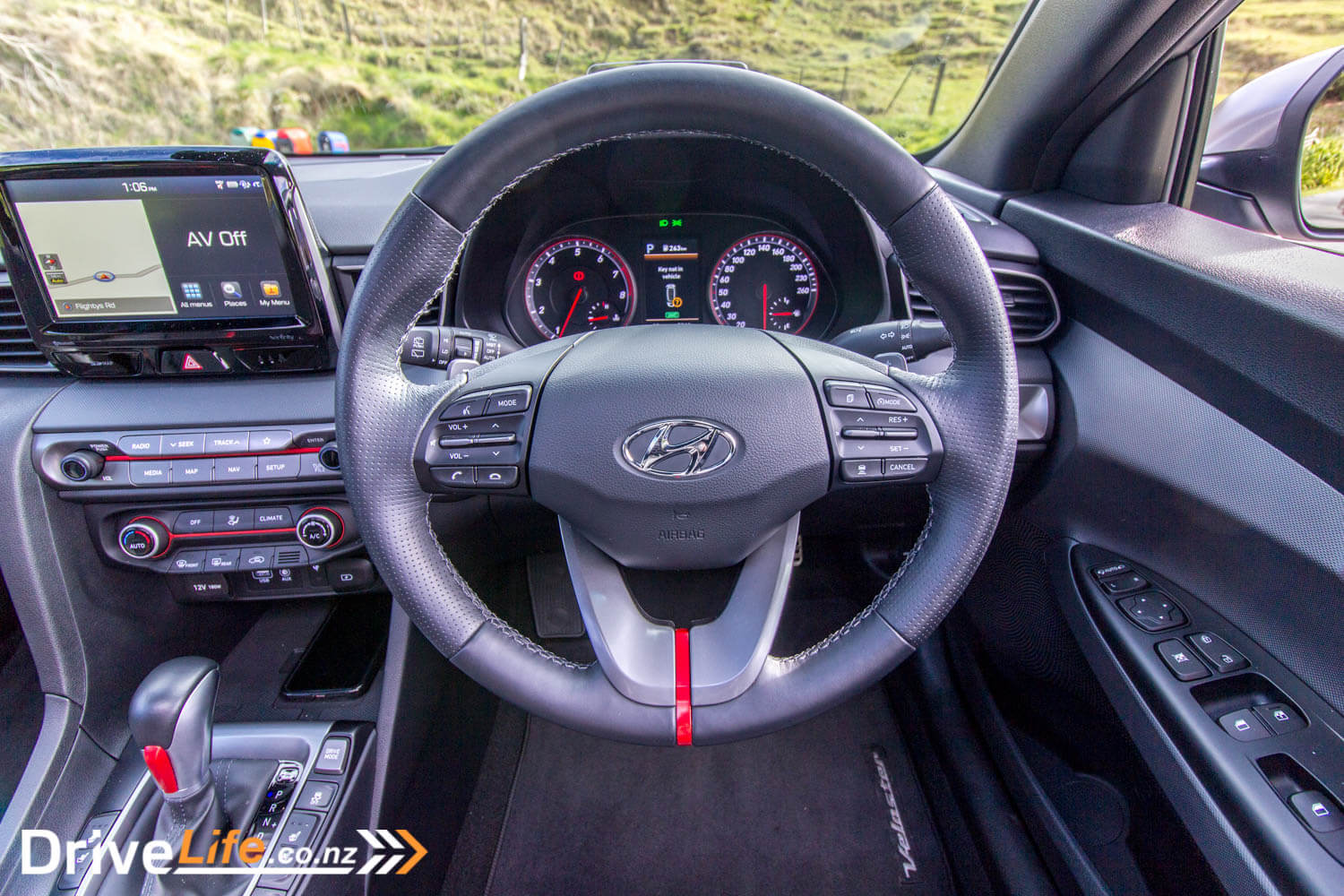
I had the i30N Fastback not long before the Veloster, and I can honestly say the ride is far better in the Velsoter. Where the i30N jitters over bumps (even in Normal mode), the Veloster almost glides. In Sport mode it gets firmer, but still very comfortable.
The HUD in the Limited model isn’t a ‘real’ HUD, instead it’s a flip-up piece of plastic, like Mazda used to do. It’s never going to be as good as a real HUD, but it’s still better than nothing at all. You get the current speed on the HUD, the current speed limit in a little road sign looking just like a speed sign, blind spot monitoring (left or right side of the car), adaptive cruise control distance and speed (or speed limiter speed), and SatNav directions. It is nicely clear, and you can select the colour of the speed limit on the display.
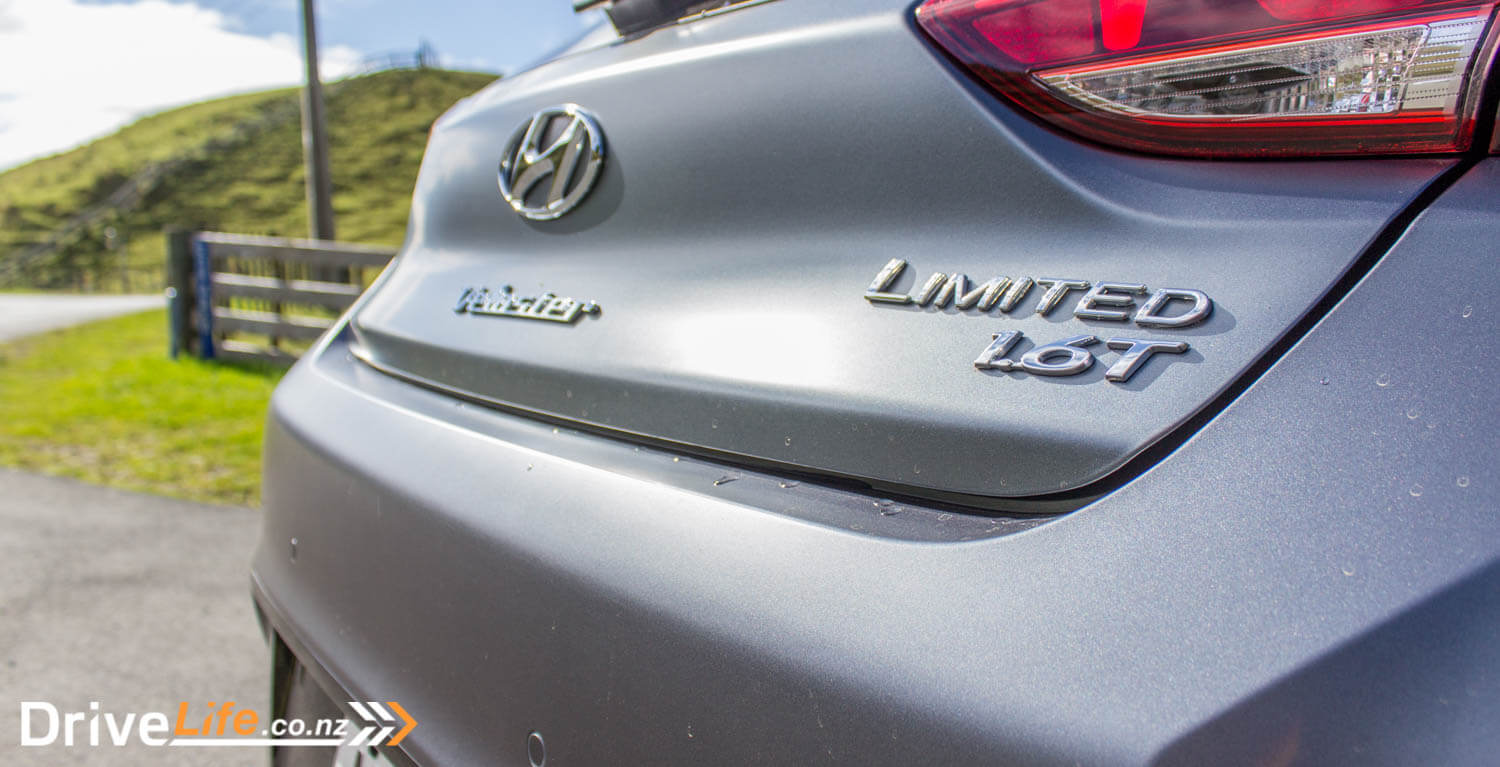
Another bonus of the Hyundai HUD is when you are approaching a fixed speed camera. You’ll get two voice prompts that a speed camera is approaching, and the current speed limit. But you also get that indicated in the HUD, with a distance to speed camera countdown. It’s a nice touch.
Speaking of speed limits, the Veloster Limited does not have traffic sign recognition, and it shows. The speed limits shown in the HUD (and on the central display) were often higher than the actual speed limit. One road, Highway 58 over The Haywards, has been 80km/h for a couple of years or so, while the Veloster showed it as being 100km/h. I found this again and again, and didn’t rely on the shown speed limit in the end. Traffic sign recognition would sort this out.
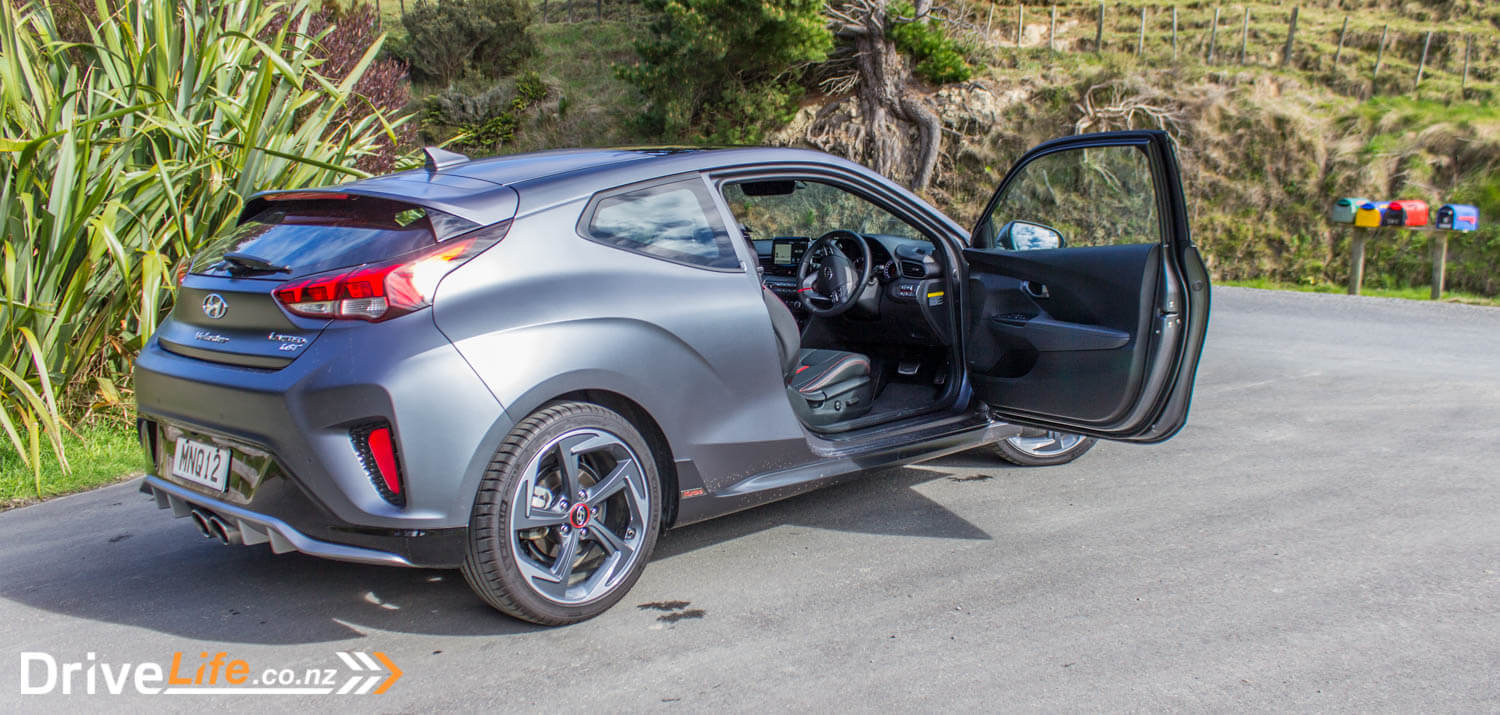
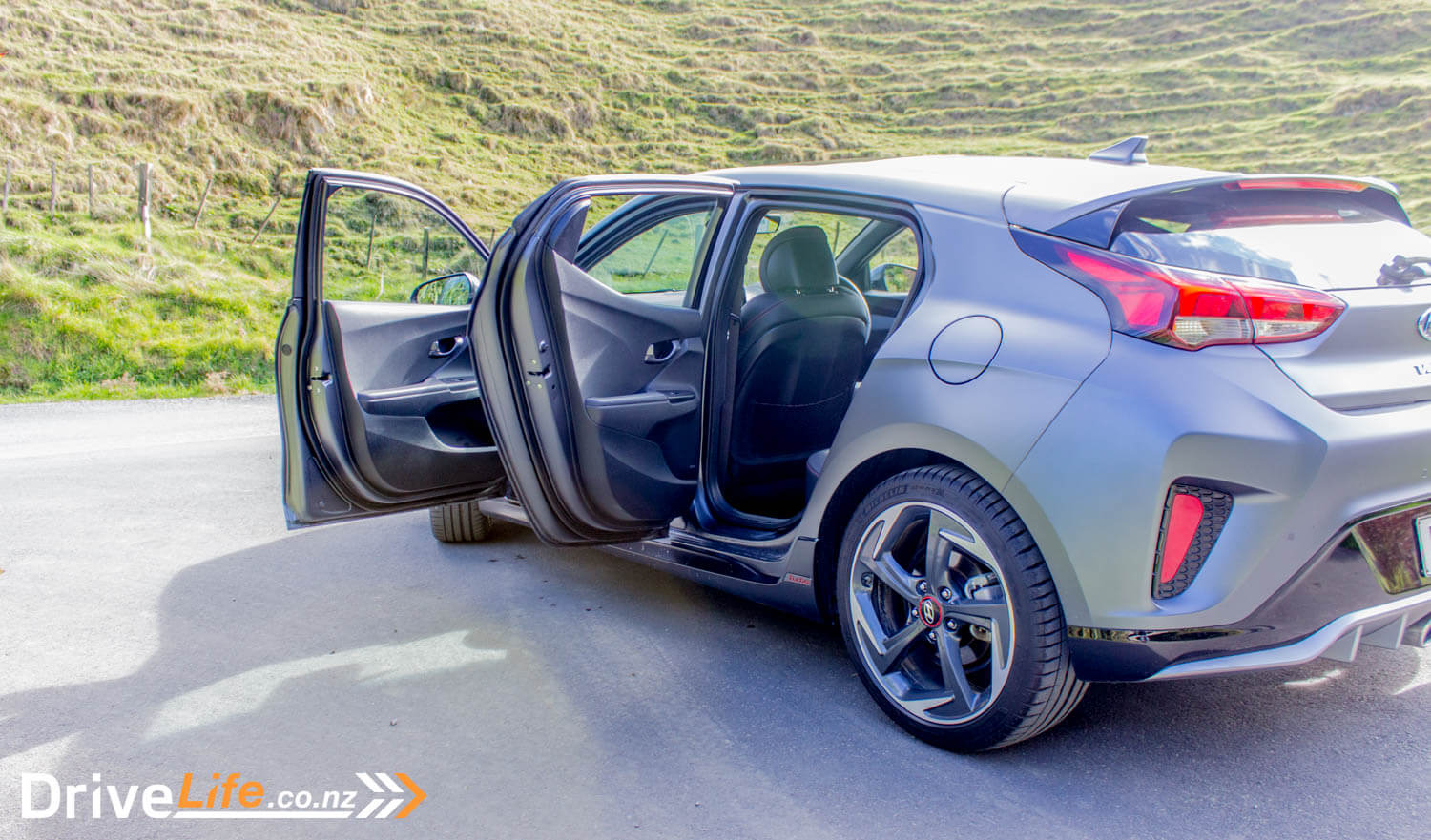
Adaptive cruise is generally very good, although sadly it won’t bring you to a stop, instead turning off at around 20km/h. You need to make sure you are listening for the ‘bing’ that adaptive cruise is now off, otherwise it will end badly. Hopefully in the next update, this will be sorted.
The Limited has lane keep assist, and while this generally worked well, it felt a bit too Big Brother for me. I also found that there were certain times when turning right, when the car would try and steer me back into my lane. Using your indicator should nullify lane keep assist, but too many times it would beep at me as I entered a median strip to turn, and the wheel would attempt to nudge me back. I turned it off, but it turns itself back on with the car. One thing that does stay on when you exit the car is the Drive Mode. Hyundai are one of the few that keeps this in the setting you left it in, after getting out and then getting back in. A small thing, but noticeable.
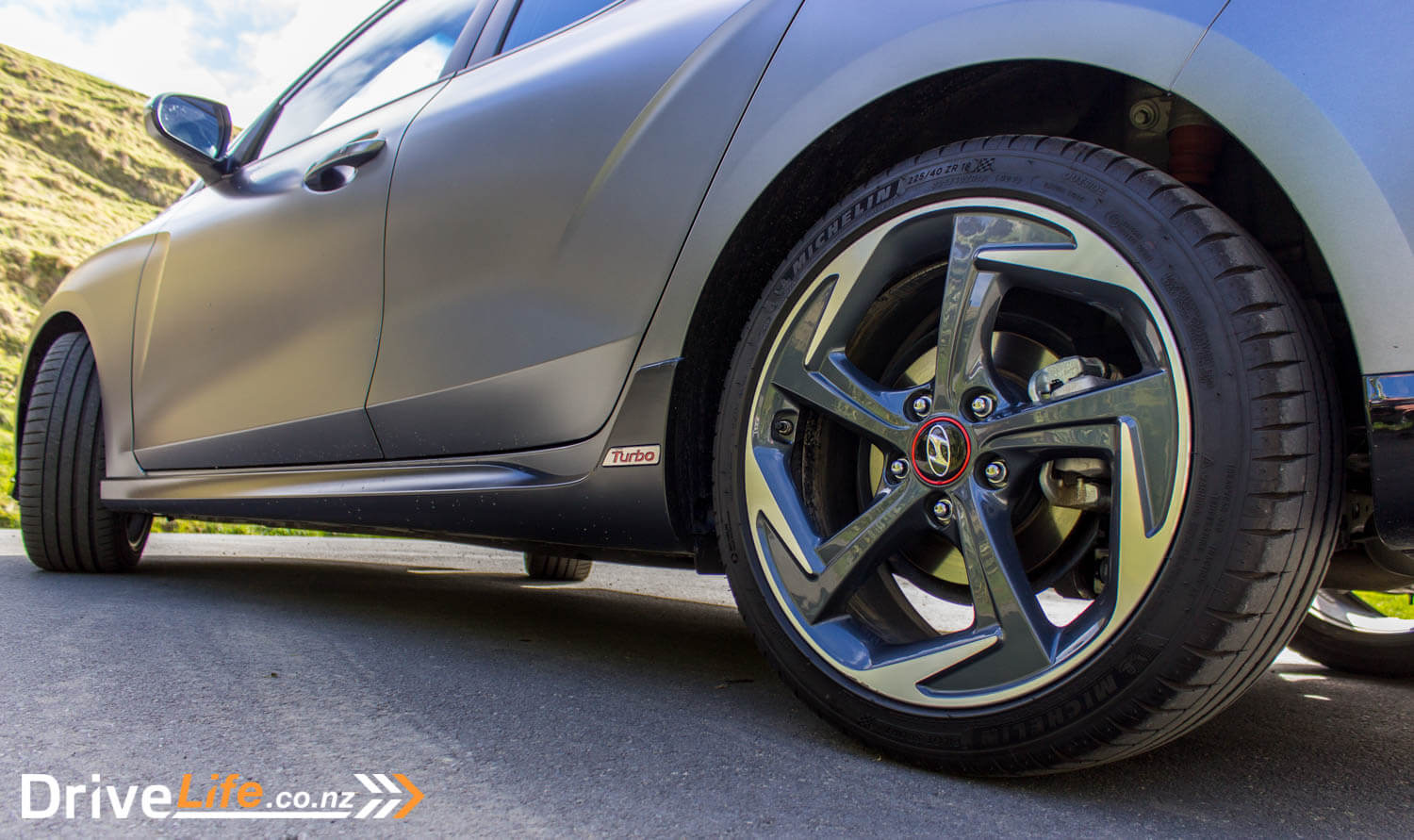
I had just stepped out of a Subaru Outback, and so one thing I instantly noticed was the visibility from inside the car. I went from having awesome visibility with the Sub, to almost none. With a tiny rear window (and possibly the world’s smallest rear window wiper), huge C pillars that include parts of the rear door on the left side, visibility is severely restricted. The driver’s side is much the same; there isn’t a door, but the pillar is the same size. Thankfully, there’s blind spot monitoring to help you out, and you need it.
Keep in mind the Veloster is only a 4-seater, in case that plays into your buying decision. There’s 3 electric windows, so the driver’s side passenger has a fixed window. Not the end of the world, but some might not like this. In comparison, the i30N is a five-seater.
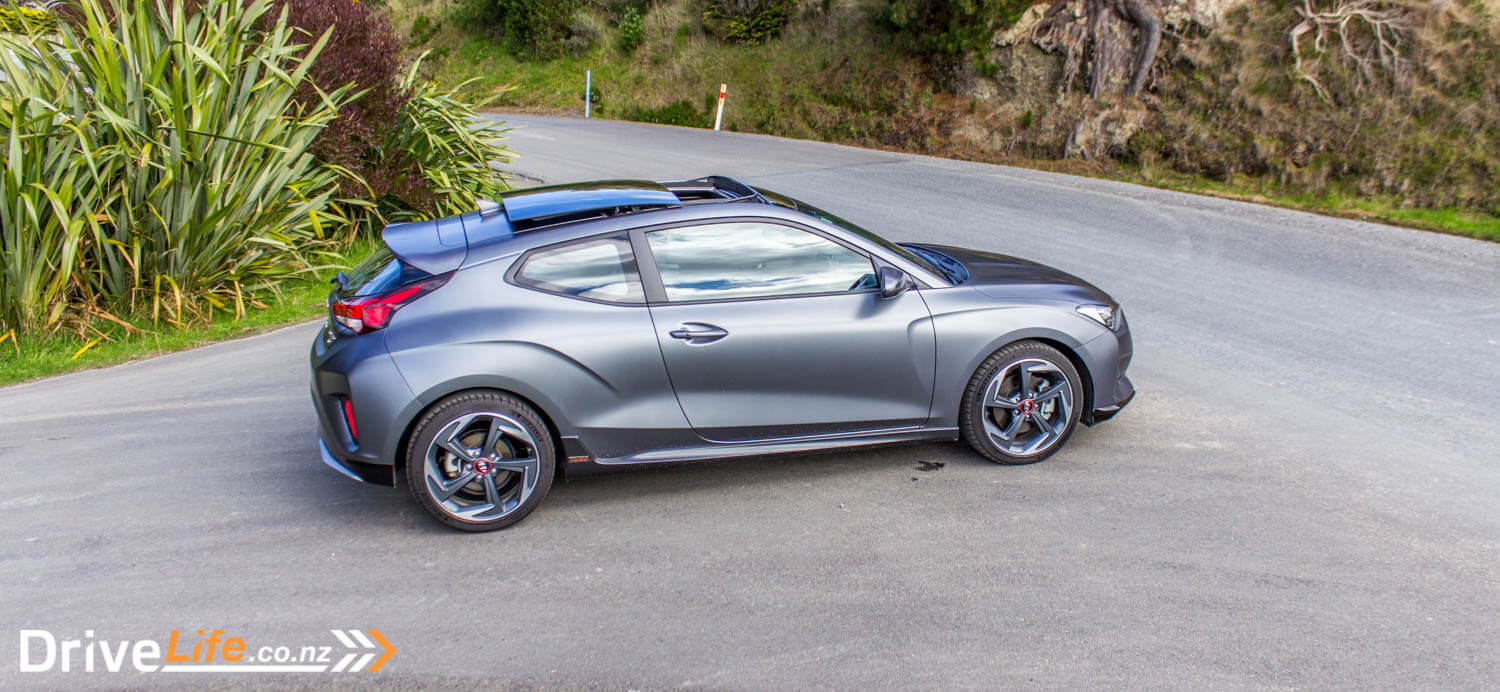
Since this is almost a shortened review, due to the fact the car is in many ways the same as the non-turbo, I want to discuss Hyundai’s infotainment system. Alistair also pointed this out recently in his review of the Ioniq. When playing a song via Bluetooth, you can’t select another song, or browse to a playlist or even a list of all your songs. The only way to do that is using a cable and then Apple CarPlay or Android Auto. It just seems so backward, and other brands manage to do this easily. Also, unless you are plugged in via a cable, you can’t use the car’s voice control to call anyone. Again, other brands do this easily. It’s forcing you to plug your phone into a USB cable, but the Veloster Limited has Qi wireless phone charging, which seems pointless if you need to plug your phone in anyway. Rant over.
The Limited model does get an upgraded sound system, replacing the standard factory unit with an 8-speaker, premium Infinity audio system with external amp. I thought the standard Veloster’s audio was just fine, but I could tell the difference, with the Infinity system delivering clear higher frequencies, and with some nice separation.
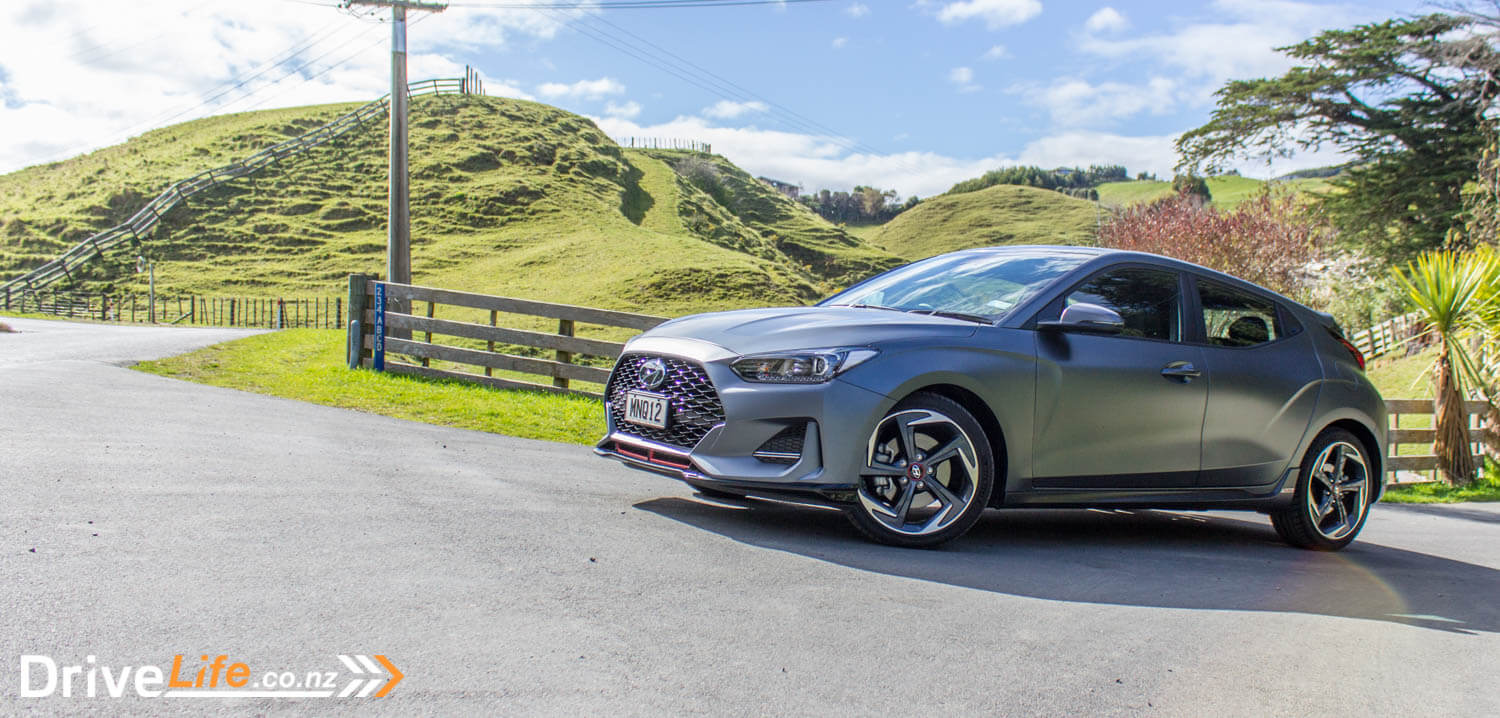
I’ll have to own up and say I made the most of the performance of this car while I had it. Not all the time, but the temptation was always there to test it out. So it was surprising to see that after 600km in the turbocharged Veloster, I managed to eke 6.9L/100km out of it. I was expecting it to be much higher, as it often is with small-capacity turbo motors. As a bonus, 6.9 is exactly what Hyundai says this car should get on the combined cycle. That’s a rare event, and brownie points to Hyundai for this achievement.
This also compares well to the 7.5 I got from the 2-litre non-turbo, so adding 40kW has meant less fuel used. All the more reason to buy the turbo version?

What’s The Competition For The 2020 Hyundai Veloster Limited?
| Brand/Model | Engine | Power/ Torque kW/Nm | 0-100km/h, seconds | Cargo capacity, litres | Fuel consumption, L/100km | Price |
| Hyundai i30N Fastback | 2.0-litre, 4-cylinder, turbo petrol | 203/353 | 6.1 | 8.0 | $59,990 | |
| Honda Civic Type R | 2.0-litre, 4-cylinder, turbo petrol | 228/400 | 5.7 | 420 | 8.8 | $59,990 |
| Hyundai i30N Hatchback | 2.0-litre, 4-cylinder, turbo petrol | 203/353 | 6.1 | 381 | 8.0 | $54,990 |
| MINI Copper JCW hatch | 2.0-litre, 4-cylinder, turbo petrol | 170/320 | 6.3 | 211 | 6.6 | $54,990 |
| Hyundai Veloster Limited | 1.6-litre, 4-cylinder, turbo petrol | 150/265 | 7.1 | 303 | 6.9 | $52,990 |
| Alfa Romeo Giulietta Veloce hatchback | 1.7-litre, 4-cylinder, turbo petrol | 177/340 | 6.0 | 350 | 6.8 | $49,990 |
| Hyundai i30N-Line | 1.6-litre, 4-cylinder, turbo petrol | 150/265 | 7.2 | 395 | 7.5 | $43,990 |
What’s The Pros and Cons For The 2020 Hyundai Veloster Limited?
| Pros | Cons |
| Fuel economy Performance Sounds Handling/ride/grip Design Brakes Audio quality | DSG gearbox Speed limit signs out Plasticky interior Visibility Over-eager lane keep assist |
2020 Hyundai Veloster Limited – Specifications
| Vehicle Type | 4-door medium hatchback |
| Starting Price | $52,990 |
| Price as Tested | $52,990 |
| Engine | 1.6-litre, turbocharged, 16 Valve (HLA), Double Overhead Cam (DOHC), Dual Continuously Variable Valve Timing (D-CVVT), Atkinson cycle, 4-cylinder petrol |
| Transmission | 7-speed DSG automatic |
| Power, Torque kW/Nm | 150@6,000rpm 265@4,500rpm |
| Spare Wheel | Space saver |
| Kerb Weight, Kg | 1,300 |
| Length x Width x Height, mm | 4240x1800x1399 |
| Cargo Capacity, litres (seats up/seats down) | 303/1081 |
| Fuel economy, litres/100km | Advertised Spec – combined – 6.9 Real World Test – combined – 6.9 |
| Tank capacity, litres | 50 |
| Towing CapacityKg, unbraked/braked | NA/NA |
| Turning circle, metres | 10.6 Small: 6-10m / Medium 10-12m / Large 12m+ |
| Warranty | 3 year 100,000km mechanical warranty 3 year 100,000km Roadside Assist 10 year 200,000km anti perforation corrosion body warranty |
| ANCAP Safety Rating | 5 Star |


